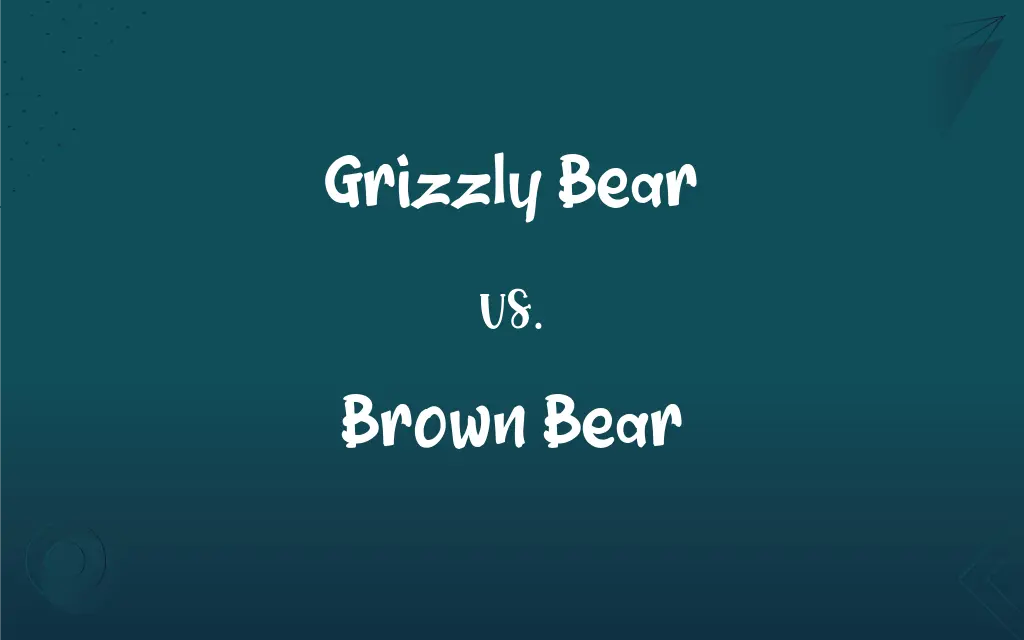Grizzly Bear vs. Brown Bear: What's the Difference?
Edited by Aimie Carlson || By Janet White || Published on December 29, 2023
Grizzly bears are a North American subspecies of the brown bear, typically smaller and with a distinct hump on their shoulders.

Key Differences
Grizzly bears are a subspecies of the brown bear found primarily in North America. They are distinguished by their physical characteristics and habitat. Brown bears, a larger group, are found in various regions, including North America and Eurasia, with diverse subspecies.
The grizzly bear is typically smaller than the Eurasian brown bear. Grizzlies are known for their distinct shoulder hump, which is a muscle used for digging. The brown bear's size and features can vary significantly based on its geographical location.
Grizzly bears often have a more aggressive reputation due to their interaction with humans in North America. Brown bears, especially in less populated areas like Siberia, may exhibit less aggression due to fewer human encounters.
The diet of grizzly bears is diverse, including plants, insects, and small mammals. Brown bears have similar diets but can have different food preferences based on their habitat, with some populations relying more heavily on fish.
Conservation status differs for grizzly and brown bears. While some brown bear populations are stable, grizzlies in certain regions, like the contiguous United States, are considered threatened.
ADVERTISEMENT
Comparison Chart
Geographical Range
Primarily in North America.
Widespread across North America and Eurasia.
Physical Characteristics
Typically smaller with a distinct shoulder hump.
Larger, size varies with location.
Aggression Levels
Often more aggressive due to human interaction.
Less aggressive in areas with fewer humans.
Diet
Varied, includes plants, insects, small mammals.
Similar but can vary, some heavily rely on fish.
Conservation Status
Threatened in some regions like the contiguous US.
Varies, with some populations stable.
ADVERTISEMENT
Grizzly Bear and Brown Bear Definitions
Grizzly Bear
Grizzly bears are characterized by their brown fur with grayish tips, giving them a grizzled appearance.
The grizzly bear's fur shimmered in the sunlight, highlighting its unique grizzled color.
Brown Bear
Brown bears, depending on their location, can hibernate during winter months.
The brown bear was preparing its den for the upcoming hibernation period.
Grizzly Bear
A grizzly is a powerful predator and omnivore native to North America.
The grizzly bear expertly caught fish from the stream.
Brown Bear
A brown bear is a large bear species found in various regions, with several subspecies, including grizzlies.
The brown bear we spotted in the Siberian wilderness was remarkably large.
Grizzly Bear
Grizzly bears are known for their solitary nature, except during mating or when mothers are with cubs.
We observed a solitary grizzly bear roaming the forest.
Brown Bear
Brown bears have a varied diet and are known for their fishing abilities, especially in regions like Alaska.
The brown bear skillfully caught salmon in the river during the fish run.
Grizzly Bear
Grizzlies play a key role in their ecosystems as apex predators and scavengers.
The grizzly bear's role in the ecosystem is vital for maintaining balance.
Brown Bear
These bears are often larger than their grizzly counterparts and can vary in color from light brown to almost black.
The brown bear's coat was a deep shade of brown, almost blending into the forest.
Grizzly Bear
A grizzly bear is a North American subspecies of the brown bear, known for its distinct shoulder hump.
The grizzly bear we saw in Yellowstone was foraging near the river.
Brown Bear
Brown bears can be found in a range of habitats, from forests to mountains and coastal areas.
We found brown bear tracks near the coastal area, indicating their diverse habitat range.
FAQs
Do grizzly bears have a specific diet?
Grizzlies have a varied diet including plants, insects, and small mammals.
What is the main physical difference between grizzly and brown bears?
Grizzlies have a distinct shoulder hump, which is less pronounced in brown bears.
Are grizzly bears and brown bears the same species?
Yes, grizzly bears are a subspecies of the brown bear.
Are brown bears larger than grizzlies?
Generally, yes, especially the Eurasian brown bears.
Where can you find grizzly bears?
Grizzly bears are primarily found in North America.
How do grizzly bears behave around humans?
They can be aggressive, especially if surprised or when cubs are present.
What habitats do brown bears prefer?
They inhabit diverse environments, from forests to mountains and coastal areas.
Can grizzly bears climb trees?
Young grizzlies can climb trees, but adults are typically too heavy.
How do grizzly bears impact their ecosystem?
As apex predators and scavengers, they play a crucial role in ecological balance.
What is the average weight of a brown bear?
It varies, but Eurasian brown bears can weigh up to 800 pounds or more.
Can brown bears be found outside of North America?
Yes, they are also found in Eurasia, like in Russia and Scandinavia.
Are grizzly bears endangered?
In some regions, like the contiguous United States, they are considered threatened.
How does the fur of a grizzly bear differ from that of a brown bear?
Grizzlies often have grayish tips on their fur, giving them a grizzled appearance.
What kind of social structure do brown bears have?
Brown bears are mostly solitary, except during mating season and mother-cub relationships.
Are brown bears good swimmers?
Yes, they are excellent swimmers.
Do brown bears hibernate?
Yes, especially in colder regions, brown bears hibernate during winter.
Do grizzly bears have natural predators?
Adult grizzlies have few natural predators, though cubs can be vulnerable to wolves and other bears.
Are grizzly bears solitary animals?
Yes, except during mating or when mothers are with cubs.
What is the lifespan of a brown bear in the wild?
They can live up to 25 years in the wild.
Are grizzly bears active all year round?
In colder areas, they hibernate during winter, but in warmer regions, they can be active year-round.
About Author
Written by
Janet WhiteJanet White has been an esteemed writer and blogger for Difference Wiki. Holding a Master's degree in Science and Medical Journalism from the prestigious Boston University, she has consistently demonstrated her expertise and passion for her field. When she's not immersed in her work, Janet relishes her time exercising, delving into a good book, and cherishing moments with friends and family.
Edited by
Aimie CarlsonAimie Carlson, holding a master's degree in English literature, is a fervent English language enthusiast. She lends her writing talents to Difference Wiki, a prominent website that specializes in comparisons, offering readers insightful analyses that both captivate and inform.






































































